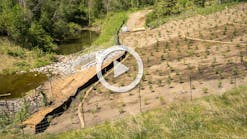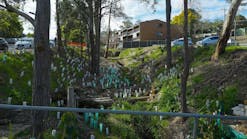In stormwater management for both temporary and post-construction measures, inlet and storm drain protection is one of the first lines of defense. It’s also a measure that often works in combination with other best management practices (BMPs) as part of an overall erosion control or stormwater management program.
Jim Nunn, facilities maintenance and repair supervisor for the city of Tacoma, WA, sought a solution to a sediment control challenge on the yard of the city’s solid waste recovery and transfer center. The site—a transfer station—is a former landfill, now capped. The city had constructed a new parking lot at the site in late 2014.
“We had a trench drain in our parking lot,” says Nunn. “We had just installed a new parking lot out here for refuse trucks. The trench drain had a biomedia in it, and with the amount of sediment that was coming off the trucks, it was plugging up when we did get a heavy rain; we just got overwhelmed. We constantly had to clean that thing out. It just packed in there.”
DuraWattle stands up to vehicle traffic at a Tacoma transfer station.
Because solid waste is constantly hauled in and out, “We have a huge amount of truck traffic, plus the customer traffic as it is a transfer station now,” says Nunn, adding that the activity generates significant sediment and debris.
The Northwest is also subject to a lot of heavy rain, Nunn points out. When the significant rain events occur, large amounts of sediment and debris have been washed into the large drains at the bottom of a slope at the east end of the parking area, clogging and compromising the performance of the biofilters. The in-grate filtration that was being used slowed to a near stop, causing water runoff to flood back over the grate and into the yard.
Nunn concluded that having to change the biomedia every time it was plugged would be a time-intensive task, thus calling for an alternative solution.
Although he found no answers in examining the city’s stormwater pollution prevention plan (SWPPP), he received a sample of a Heavyweight DuraWattle from Chris Ott, the city’s senior environmental specialist.
Heavyweight Sediment Control Solutions’s Heavyweight DuraWattle is a flexible sediment barrier designed to address the problems and failures of sediment control BMPs. Constructed from UV-resistant material, it can also withstand vehicle traffic and quickly rebound back to shape and can be applied on soil, sidewalks, or hard surfaces.
According to Heavyweight Sediment Control Solutions, ASTM field tests demonstrate a 96.6% sediment retention and 58% turbidity reduction.
The DuraWattle is designed as a lightweight continuous barrier with interlocking ends. The wattle doesn’t absorb water or pollutants; water flows through it rather than ponding or backing up. The square profile design helps control dust. The wattle is reusable.
Nunn was impressed with the wattle and decided it would address the challenge on the transfer station site. He favored its durability and that it was designed to be driven over by vehicular traffic. That was a significant factor, given the drains were located at the entrance of the parking lot and some 60 trucks drive over them several times a day.
Because the DuraWattle is typically used as a perimeter control BMP, it is manufactured with a tail section to trench and backfill on soil or sidewalk applications to prevent undermining.
“I realized I could adapt it to my needs by installing it backwards with the tail anchored down by the grate behind the wattle rather than buried in the dirt in front of the wattle,” notes Nunn. “This enables the sediment to be trapped before entering the trench.”
Nunn initially requested 300 feet of DuraWattle from manufacturer Heavyweight Sediment Control Solutions to cover the 260 feet of trench drains needing protection.
The installation took two hours as crews pulled the grates, removed the sediment that had settled on top of the biomedia filter inside the trench, installed the tail, and reinstalled the grate to anchor the DuraWattle in place. The DuraWattle’s tail section did not require further securing, as the weight of the drain grates was sufficient to hold it in place, even when being driven over.
After the first rains, Nunn was impressed, noting a significant reduction in the amount of silt being washed into trenches.
The DuraWattle had stopped not only sediment but also some of the larger debris such as paper, wrappers, and ear protection buds, and prevented the drain from getting clogged and overflowing.
Now, instead of a weekly changing of the biomedia, maintenance of the DuraWattles entails flipping them and using a sweeper attachment on a Bobcat to sweep the debris that has collected along the wattle.
Once in a while, a wattle will get torn up by the impact of the ongoing traffic or by a truck driving over it, but the city has only had to replace a few, says Nunn.
“With the amount of heavy trucks running over it, it’ll tear up and come apart. We just slap a new one in, which is kind of nice,” he says. “You can pull out a section of it and replace it, so it’s worked out well for our needs.”
The DuraWattles are now part of the city’s overall SWPPP and are used in conjunction with other BMPs such as catch basin filters. The city does a lot of surface sweeping as well.
“There’s a lot of sediment and real fine stuff, so we do monthly inspections,” says Nunn, adding that these are built into the budget as the “cost of doing business and doing the right thing.”
Through monitoring the influent and effluent on the site, city staff has noted a difference. “We have done really well with results,” says Nunn.
A New Approach
Jim Spotts, owner of Southeast Environmental Consultants, is a soil scientist specializing in erosion and sediment control. Years ago, Roger Singleton, owner of Silt-Saver, had contacted him to request a third-party evaluation of a product Singleton had developed. Spotts says he is always interested in developing new BMPs.
They visited a cul-de-sac on a construction site Singleton owned that had a drain in the middle of it, a road that wrapped around it, and a fire hydrant nearby. They set up a typical BMP normally used around inlets: four stakes wrapped with silt fence.
They raked soil around the outside of the silt fence material. Spotts stood in a hole where the drain was located, preparing to take water samples from water that would leak through the silt fence as Singleton activated the fire hydrant.
Spotts looked up to note that the sides of the silt fence between the posts were beginning to cave inward and rapidly climbed out of the hole as the stakes collapsed.
“I was concerned about the effectiveness of it, particularly since the water was not very high on the side of the silt fence—maybe 10 inches, which wasn’t much,” he says.
They agreed to repeat the field test the next day with the Frame and Filter Assemby BMP Singleton had designed.
“He had a black frame with a piece of geotextile material wrapped around it like an inverted ice cream cone,” notes Spotts. “We put some gravel around the bottom of it so the water wouldn’t escape underneath around the lower lip of it. He turned on the water. I waited and waited for the thing to collapse. Surprising to me and everyone else, it did not collapse; the water rose up to the very top of the container itself with no collapse.
“I was very impressed with it,” he says. “Structurally, the round circle around the drop end attempted to go into compressions as water exerts pressure equally on all sides, so there’s no chance of it collapsing inward like the one we did with the four stakes and silt fence. That’s very important.”
The second factor was that the fabric slowed the water down enough so that much of the sediment collected on the outside and allowed clearer water to pass on through, which was the water Spotts had sampled.
Spotts says the Silt-Saver devices have “caught on very well here in Georgia. They’re used extensively by the DOT as well as construction—private practice, commercial, and industrial. They’re very popular, and I can say they do a very fine job.”
Spotts points out that drain and inlet protection is just one BMP that must be employed on a site where there’s going to be potential for erosion and sedimentation.
“To say that by itself it is sufficient is certainly misleading, and it is not to be construed to be the all-in-one answer,” he says. “As with all BMPs, there also is a certain amount of maintenance required. Once the pores in the filter clog up, it then becomes a dam rather than a filter and you need to replace the filter fabric on the outside.”
An approach used by some is to let the fabric dry, “beat” the clay sediment off with a board, and put the fabric back on again. “That’s considered a
less expensive way of doing it,” says Spotts. “I don’t know that it lasts a lot longer. It might be easier just to replace the entire thing in terms of saving time and money.”
Maintenance or replacement should be performed when the sediment rises halfway up the height of the fabric, says Spotts.
Silt-Saver offers a two-stage filter for its Frame and Filter Assembly. The staged-release woven fabric with different sieves in each of the stages produces different efficiencies along with different flow rates. The first 12 inches vertical starting at ground level offers 98% efficiency with 180 gallons per minute, per square foot flow rate, says Singleton. The next 12 inches offers a higher 1,350-flow rate.
“This two-stage concept limits flooding with the controlled release of stormwater,” says Singleton. ”Sediment is transported by stormwater. To only address the efficiency of a practice without addressing the stormwater is a setup for failure.”
Silt-Saver also has incorporated the staged-release concept into two of its woven silt fences, addressing the controlled release of the impounded stormwater and reducing the hydrostatic pressure behind the fence that can lead to undermining of the fence or total system failure, says Singleton.
Although this type of BMP is often used in conjunction with others for comprehensive erosion control and stormwater mitigation, what would not necessarily work well with it is the use of polymers, says Spotts.
“The polymers would cause the clay part with the fines to quickly clog up the pores, making it turn into a dam rather than into a filter,” he says. “I would use something like this to get out the coarse material for the sands and silts as quickly as possible and then later on use polymers as necessary. Polymers are much more effective on the finer-clay sized particles than they are on the sands and silts.”
While not everyone ascertains the effectiveness of the BMP through monitoring influent and effluent, Spotts points out that is exactly what his company does, in keeping with a Georgia requirement to monitor for the quality of water being discharged from a construction site.
“It’s part of the NPDES stormwater program,” he adds. “We monitor water coming in and water coming out. We have criteria that say the water going off of a site may not exceed more than 25 NTUs [nephelometric turbidity units] above what the water is coming into the site. If you have an upstream site with 100, your allowable discharge off the site is 125.” For more pristine environments, such as a trout stream, discharge cannot be more than 10 NTUs above background, “so in that case, it would only be 110,” he says.
“You can see 125 in the water, and 110 doesn’t look a whole lot better,” he notes. “In terms the ecosystem, there’s a real significant impact. We want to keep our waters clean. Water is the most important resource that the state of Georgia has.”
In addition to being a consultant for private contractors, Spotts is also a code enforcement officer for the city of Chamblee, a bedroom community outside Atlanta.
“I issue stop-work orders and citations for sites that have discharge of water off the site or have the silt fences down,” he says. “Whatever the BMP deficiency is, I can cite them for that. My approach has been, rather than to cite them and cause a lot of anxiety on the part of contractors, to educate them in the proper use of the correct BMP, so the problems don’t begin to start with.
“Within Chamblee, contractors say I’m their worst enemy. Outside Chamblee, I’m their best friend, and yet I teach the same thing coming and going.”
Spotts notes that one significant problem is that the judicial system does not place as much importance on environmental crimes as it does others.
“Although the federal government allows a very high penalty for violations of the NPDES program, most city, county, and municipal judges treat this as a minor offense and don’t put a serious value on the monetary fines,” he says. “The result is that some contractors laugh as they go out the door. They pay the check to the clerk and keep on going, and they haven’t even bothered to correct the problem on the site. I really have a problem with that.”
Spotts contends that field inspectors could be much more effective if they knew they had the backup of the judicial system to enforce the laws and stress the importance of contractors abiding by the rules.
Although Spotts is satisfied with the performance of the Silt-Saver devices, he says the state of Georgia is always on the lookout for new devices as well.
“We in Georgia have a manual of the acceptable best management practices. I have a problem with the word ‘best’ because yesterday’s best is not the same as today’s best. It’s an evolving process to develop new products.
“Roger has hit on a real gold mine here with the Silt-Saver, so my hat is off to him. He has made significant improvements in the program. I can’t tell you how many hundreds of those things I see almost on a daily basis as I go from one site to another.”
Redmond Way Regional Stormwater Treatment Facility
The Redmond Way Regional Stormwater Treatment Facility in Redmond, WA, has installed more than a thousand filter cartridges to address polluted runoff. It’s all part of an effort by the city to improve the quality of the water flowing from city streets into the Sammamish River.
Redmond recently adopted a federal permit for stormwater discharge to improve environmental protection and comply with federal and state laws. Conditions of the permit require the city to enhance efforts to clean the stormwater before it gets to local water bodies.
City officials had worked with the Washington State Department of Ecology to develop a plan for constructing regional facilities complying with the city’s permit and the state’s stormwater management guidance manual. The construction of the regional facilities is funded by the stormwater capital improvement program, with support from developers and state grants.
The city’s regional stormwater facilities plan utilizes regional stormwater facilities to meet its water-quality goals, support new development required by the Growth Management Act, and do so in a cost-effective manner.
Regional stormwater controls are facilities designed to manage stormwater runoff from multiple projects or properties through a city-sponsored program in which individual properties may assist in the financing of the facility, and the requirement for onsite controls is either eliminated or reduced. In Redmond, developers can pay a fee in lieu of constructing onsite facilities.
Oldcastle Precast’s Perk Filter Media Filtration Device is cartridge filtration designed to remove and retain pollutants from stormwater runoff. It can be used with a variety of different media to address site-specific pollutants of concern. The Perk Filter system captures sediment, metals, nutrients, and petroleum hydrocarbons, as well as gross solids and trash, to significantly reduce the total pollutant load in stormwater runoff.
Standard cartridge heights are 12 inches and 18 inches. The 24- and 30-inch cartridges use modular stacks.
PerkFilter Media Filtration is designed for flexible configurations that can be applied in vaults, manholes, and catch basins with variable inlet and outlet locations, to provide high-efficiency treatment in a compact footprint. Field and lab tests show total phosphorous removal of more than 60% and total suspended solids removal of more than 80%. A pretreatment chamber is designed to prolong media lifespan by removing gross pollutants.
The modular cartridge construction design provides for efficient media replacement and cartridge handling. An integrated bypass system reduces construction costs by eliminating the need for a separate bypass structure.
From October to December 2014, some 1,068 Perk Filter cartridges measuring 12 and 18 inches were installed at the Redmond Way Regional Stormwater Treatment Facility. They were stacked with the 18-inch units on the bottom and the 12-inch units on top to form 534 stacks to provide a treatment flow rate of 9,078 gallons per minute. The vault containing the stacks is 16 feet by 213 feet.
Chris Demarest, product development manager for Oldcastle Stormwater Solutions, says, “The system removes total suspended solids, trash and debris, nitrogen, phosphorus, metals, hydrocarbons, and other pollutants.” He adds that typically, stormwater treatment units have been installed on a project-by-project basis.
This system and other large regional systems in Redmond are designed so that not all individual properties must treat their own stormwater onsite, which reduces the constraints developers have when designing their projects, says Demarest, adding that unlike installations that treat runoff onsite on individual lots, this unit treats runoff from a region of the city.
Demarest says the Perk Filter was chosen “because of its high pollutant removal capabilities, its high treatment flow rates, its innovative design, and its value.”
The system is being maintained annually. The maintenance cycle for the system can be modified based on the pollutant loading. The system has a turbidity meter installed for monitoring the influent and effluent.
The use of the Perk Filter fits into the city’s overall stormwater management program as a matter of compliance with its stormwater permit, as it is a Washington Department of Ecology-approved manufactured stormwater treatment device.







